Your instructor has patiently taught. Other students have devoted their time, energy, and pain for your development. Show respect to them by demonstrating that you are attempting to learn. Help improve the group through you individual efforts.
By observing tests, your instructor can note areas in need of particular improvement for each student. It allows for planning future teaching so as to solve problems common to the whole dojo.
Aikido has a variety of tai-sabaki (body movements), waza (techniques) and ukemi (breakfalls). By concentrating temporarily on a specific selection of waza and their appropriate ukemi, you can begin to master a limited repertoire that forms the basis of future training. At the kyu (white or coloured) belt level it is essential to develop basic coordination and reflexes that can lead to the flow, harmony, and power of the dan (black belt) level.
Testing also reminds you of the importance of understanding the Japanese terminology as used in practice all over the world.
Aikido has no sporting or competitive component; there is only jibun no shiai (contest with oneself). As the testing level rises, the kougeki (attacks) and ukemi become more challenging. In dan examinations the situation must preserve the bu (martial) aspect that is essential to Aikido training without losing the equally important quality of harmony
During a test you must be prepared to perform continuously for fifteen minutes or more. The physical stamina and mental concentration required for an examination can gradually be introduced into your regular training, thereby making it of greater value to yourself and your partners. Of course, this also contributes greatly to your overall health.
Aikido keiko (training) is a life-long path of self-discipline and inner exploration. Periodically it is useful to assess profoundly what you have learned. Each test represents an obtainable goal that can lead to further insight. It can also provide the emotional satisfaction of achievement that we all need as we progress along a most challenging path.




